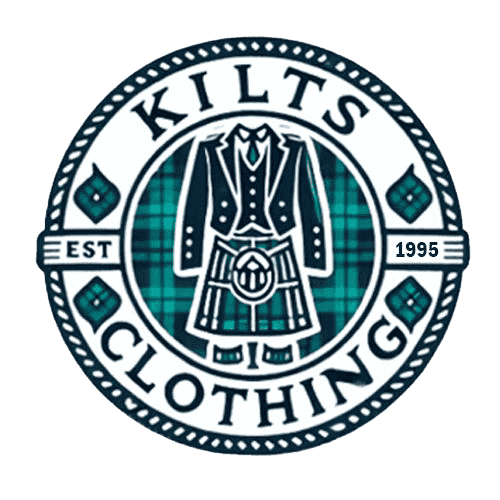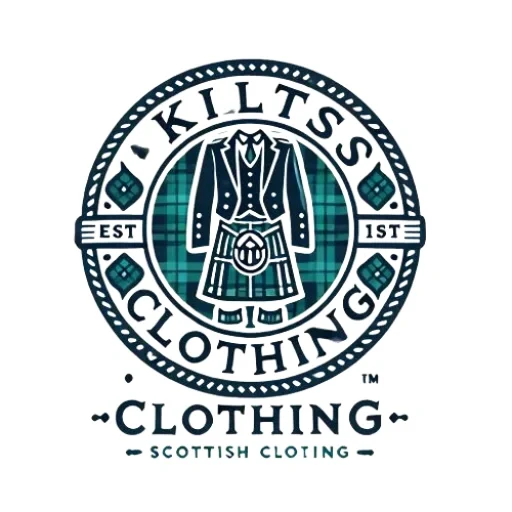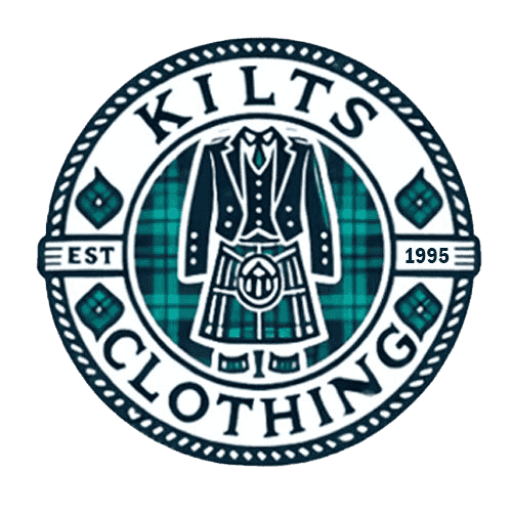Formal Kilt: A Timeless Garment for Modern Elegance
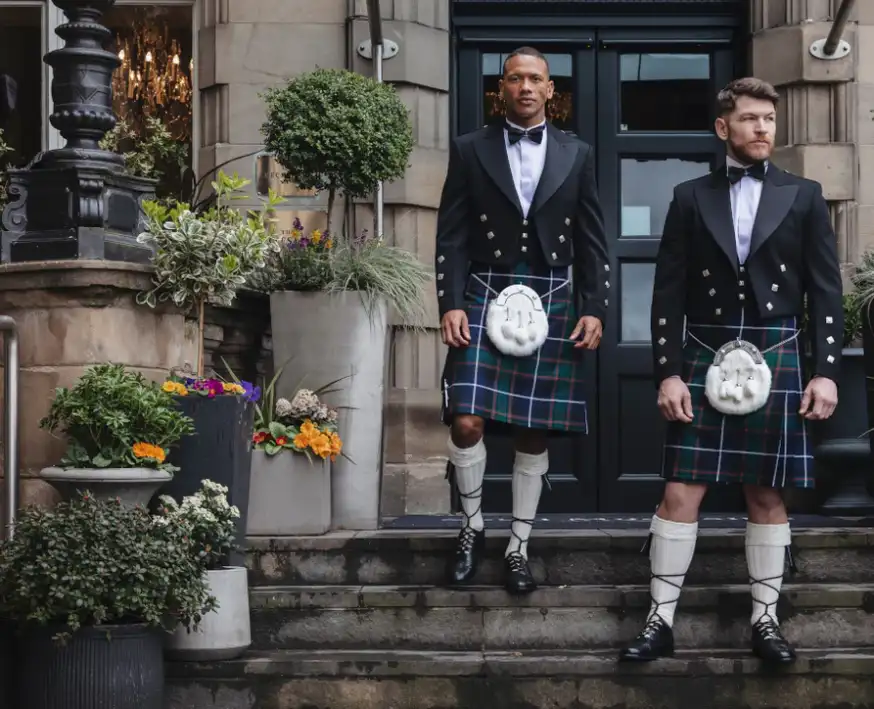
Men's Kilts: A Timeless Symbol of Elegance and Heritage
Men’s kilts have long represented the rich cultural legacy of Scotland, embodying sophistication and tradition. Their distinctive charm has made them a popular choice for formal events, from weddings to black-tie gatherings, across the globe.
This guide explores kilts' history, types, and significance, along with tips on how to wear and accessorize them for various occasions.
The History of the Kilt
Scottish Origins: The men’s kilt originated in 16th-century Scotland, where it was traditionally worn by members of Highland clans. Even today, the kilt is a powerful symbol of Scottish heritage and pride.
Cultural Significance: Throughout history, kilts have been worn not only in ceremonial contexts but also in battles, symbolizing courage, unity, and identity.
Evolution Over the Centuries: Kilts have evolved from the large "great kilts" that covered the entire body to the more refined styles we see today. While traditional designs remain central to their identity, modern kilts include functional variations such as utility and sport kilts.
Types of Kilts
- Traditional Kilts: Made from heavy wool, these kilts feature deep pleats and iconic tartan patterns reflecting clan affiliations. They are commonly worn at cultural events like Highland games and ceremonies.
- Modern Kilts: Crafted from lighter materials and featuring various designs, modern kilts are versatile and suitable for casual or business-casual settings.
- Sport Kilts: Specifically designed for athletic purposes, they prioritize comfort and flexibility, making them ideal for physical activities.
- Utility Kilts: Blending traditional aesthetics with practicality, utility kilts come equipped with pockets and are perfect for everyday wear, work, or outdoor adventures.
- Casual Kilts: Comfortable and stylish, casual kilts offer a relaxed alternative for informal gatherings, festivals, and day-to-day wear.
What Is a Formal Kilt?
A formal kilt is a polished and elegant version of the traditional garment designed for upscale occasions.
Key Features:
- High-Quality Materials: Formal kilts are typically made from premium wool, ensuring durability, structure, and a refined appearance. Some may even include luxurious fabrics like silk or cashmere.
- Occasions: These kilts are a staple at weddings, black-tie events, and other formal gatherings, often paired with complementary accessories for a complete look.
Materials Used in Kilts
- Wool: The most traditional fabric known for its warmth, durability, and timeless appeal. Wool is widely used for both formal and casual kilts.
- Blended Fabrics: Combining wool with synthetic fibers creates a more flexible and lightweight material, which is especially common in utility and sport kilts.
- Leather: Some modern and utility kilts feature leather for a bold, rugged look that stands out from the traditional designs.
Designs and Patterns
- Tartan Patterns: Traditional kilts often feature tartan designs deeply rooted in Scottish heritage and represent specific clans or families.
- Modern Patterns: Modern kilts may incorporate solid colors or innovative patterns for a contemporary twist while still paying homage to their roots.
- Custom Designs: Personalized kilts allow individuals to choose unique combinations of colors, fabrics, and patterns to reflect their personal style or lineage.
Conclusion
Men’s kilts are timeless garments that blend heritage with elegance, making them suitable for both traditional and modern occasions. Whether you opt for a classic tartan kilt or a more contemporary design, kilts offer endless possibilities to express your style while honoring their rich cultural significance.
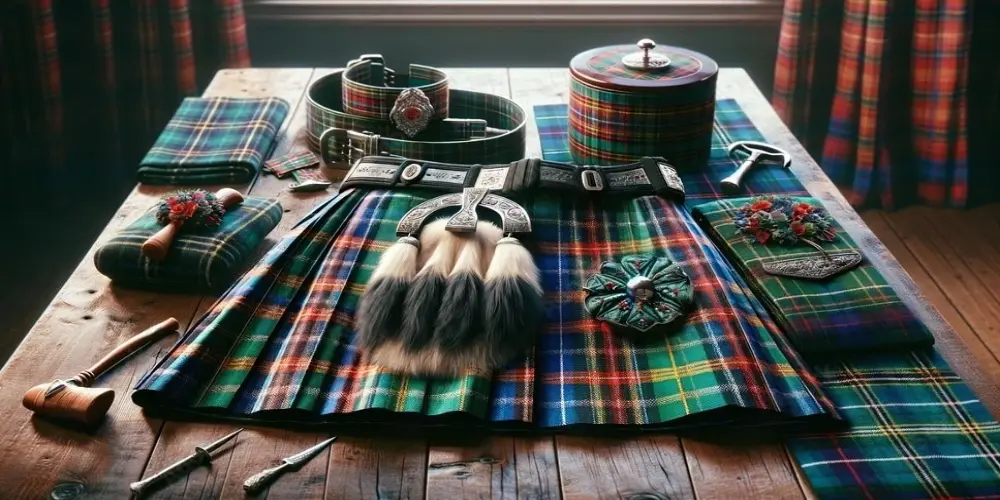
How to Wear a Formal Kilt
Start with the Kilt
: Begin by wrapping the kilt around your waist, ensuring the pleats are positioned at the back and the apron overlaps at the front. Make sure the kilt is securely fastened.
Add the Kilt Belt
: Secure the kilt further with a decorative belt. The belt enhances the look of the kilt while adding a touch of tradition.
Please put on the Sporran
: Center the sporran on the apron, allowing it to hang from a chain or strap. This accessory is both functional and ornamental.
Wear the Kilt Jacket
: Opt for a Prince Charlie or Argyll jacket for formal occasions, which should fit snugly over a dress shirt.
Accessorize with a Kilt Pin
: Attach the Kilt Pin to the bottom right side of the apron. It serves to keep the apron in place and adds a decorative flair.
Complete the Look with Kilt Socks and Shoes
: Pair your kilt with kilt hose (socks) and traditional shoes like ghillie brogues. Ghillie brogues are essential for a polished, formal appearance.
Accessories for Formal Kilts
- Kilt Belt: This wider-than-usual belt helps secure the kilt while enhancing its style with ornate buckles.
- Sporran: A necessary accessory for carrying small items, the sporran also elevates the kilt’s appearance. Options range from casual to formal styles.
- Kilt Pin: Positioned on the apron, the kilt pin adds decoration while holding the fabric in place. It often features traditional Scottish symbols.
- Ghillie Brogues: These shoes with long laces wrapped around the ankles are integral to completing the formal kilt outfit.
- Kilt Socks and Flashes: Kilt socks, paired with flashes (small garters), add color and help complete the kilt ensemble.
- Kilt Jacket and Waistcoat: The Prince Charlie jacket, often paired with a waistcoat, is a popular choice for formal events, rounding off the kilt look.
Occasions for Wearing a Formal Kilt
- Weddings: Kilts are perfect for grooms, groomsmen, and guests at weddings. Wedding kilts are often worn with specific tartan patterns to signify personal or family heritage.
- Black-Tie Events: Ideal for formal dinners and galas, the kilt is paired with a Prince Charlie jacket for a sophisticated look at black-tie affairs.
- Cultural Events: Celebrating occasions like Highland Games or Burns Night with a kilt pays homage to tradition and cultural pride.
Kilt Etiquette
- Dos:
- Wear the kilt with respect for its cultural significance.
- Ensure your kilt fits properly for both comfort and appearance.
- Choose accessories that match the formality of the occasion, as they help elevate the overall look.
- Don'ts:
- Treat the kilt as more than a costume—a garment with deep historical value.
- Avoid mixing casual and formal elements inappropriately. Stick to the level of formality suited to the event.
Buying Guide
- Quality: Look for a high-quality kilt made from durable materials. Well-crafted kilts not only last longer but also maintain their aesthetic appeal.
- Fit: Ensure that your kilt fits correctly. For a tailored experience, consider a custom-made kilt for a perfect fit.
- Design: Choose a tartan pattern that holds personal or familial meaning. Tartan designs are a meaningful way to showcase heritage.
- Accessories: Complement your kilt with matching accessories, like kilt pins, belts, and sporrans, for a complete, polished appearance.
Custom-Made vs. Ready-Made Kilts
- Custom-Made Kilts: Custom kilts are tailored to your exact measurements, ensuring a perfect fit. With personalized designs and unique tartans, custom kilts offer superior quality and uniqueness, though they are cheaper.
- Ready-Made Kilts: These are readily available and more budget-friendly. While they come in standard sizes and commonly available tartans, they’re ideal for those who need a quick or affordable kilt.
Caring for Your Kilt
- Cleaning: Kilts should be dry-cleaned to preserve their fabric and pleat sharpness. Dry cleaning helps maintain the garment’s longevity.
- Storage: Always hang your kilt to prevent wrinkles and preserve its shape. A dedicated kilt hanger is ideal for keeping it in top condition.
- Repairs: Address any damage promptly by seeking professional repair services to ensure your kilt remains pristine.
Alterations and Adjustments
- Waist Size: Adjust the kilt straps for a comfortable, snug fit around your waist.
- Length: Ensure the kilt falls around the middle of your knee. The right length is crucial for comfort and maintaining the traditional look.
- Pleats: Maintain well-pressed pleats to preserve their sharpness. Regular professional pressing will help keep your kilt looking its best.
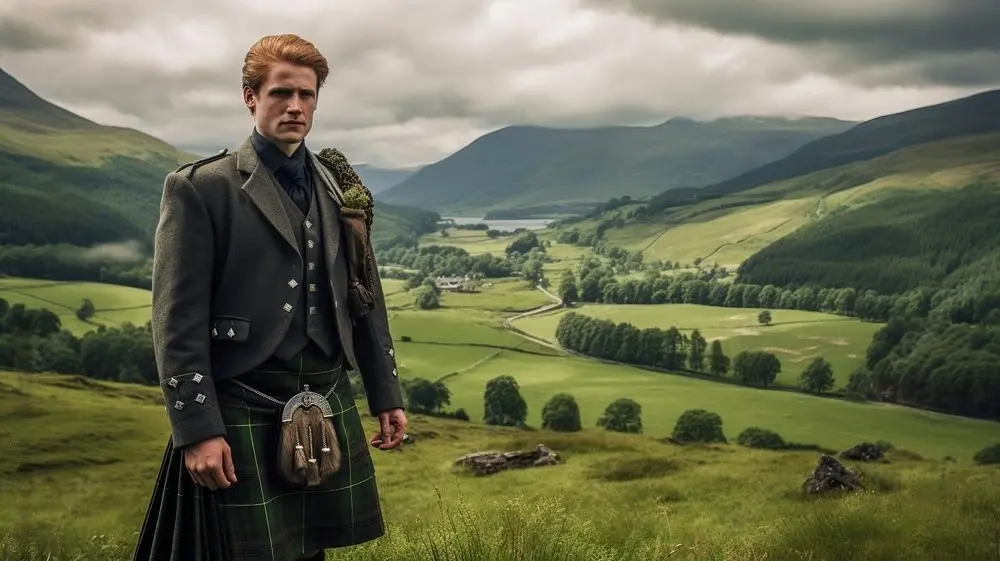
Cultural Significance
Scottish Heritage
: The kilt is a symbol of pride, tradition, and identity. Wearing one is a powerful connection to Scottish culture and its long-standing traditions.Irish kilts
typically feature solid colors or specific tartans, reflecting Ireland's rich cultural history. These kilts are often worn during cultural celebrations, emphasizing their deep ties to Irish heritage.Wearing Kilts
: Donning a kilt is a way to connect with your ancestry and cultural roots. It serves as a proud representation of heritage.
Modern Trends
Casual Kilts
: These are designed for comfort and ease, perfect for everyday wear. They offer a relaxed yet stylish option for those wanting a comfortable look.Utility Kilts
: Known for their practical design, utility kilts feature pockets and durable fabrics, making them suitable for various activities and offering both function and style.Fashion Kilts
: A contemporary take on the traditional garment, fashion kilts incorporate modern designs and fabrics, giving them a fresh, trendy appeal.
Celebrity Influence
Ewan McGregor
: Frequently spotted wearing a kilt, McGregor showcases his Scottish pride. His kilt choices have been widely admired for their style and cultural significance.Gerard Butler
: A supporter of Scottish heritage, Butler often wears kilts to red-carpet events, helping boost the garment's popularity among modern audiences.Sam Heughan
: Best known for his role in Outlander, Heughan regularly dons kilts both on and off-screen. His influence has inspired many of his fans to embrace the kilt style.
Kilt Accessories: Completing the Look
Kilt Belt
: Wider and more ornate than a typical belt, the kilt belt is essential for securing the kilt and adding a stylish touch.Sporran
: A functional yet decorative pouch worn at the front of the kilt. Sporans come in various styles, including day, semi-dress, and dress versions.Kilt Pin
: A decorative element that helps secure the kilt's apron in place. Kilt pins often feature traditional Scottish motifs, adding a layer of elegance.Ghillie Brogues
: These traditional shoes complete the kilt ensemble, known for their long, distinctive laces that wrap around the ankle.Kilt Socks and Flashes
: Kilt socks are held up by flashes, which are small garters that add color to the kilt outfit.Kilt Jacket and Waistcoat
: The Prince Charlie jacket is a popular choice for formal occasions, adding sophistication to the overall look.
Kilt Patterns: Choosing the Right Tartan
Traditional Tartans
: These tartans represent family or clan heritage. Wearing a traditional tartan connects the wearer to their ancestry and cultural legacy.Modern Patterns
: These tartans feature contemporary designs, offering a unique and fresh option for those seeking something different.Custom Options
: Custom tartans allow for tailored patterns with personal or family significance, providing a unique touch to the kilt.
Who Wears Kilts?
Men
: Traditionally worn by men, kilts are a staple for formal and cultural occasions, such as weddings, festivals, and ceremonies.Women
: Increasingly popular among women in modern fashion, female kilts are gaining recognition and becoming a fashionable choice in various circles.Celebrities
: Celebrities have played a key role in popularizing the kilt, wearing it at events and in the media, and helping bring it into mainstream fashion.
Conclusion
- The formal kilt is more than just a garment; it embodies tradition, elegance, and cultural pride. Whether for a wedding, a formal gathering, or a celebration of your heritage, wearing a kilt connects you to a deep history while showcasing a timeless style. Invest in a high-quality kilt, learn how to wear it properly, and embrace the unique charm it brings to any event.
FAQs
A formal kilt is a refined version of the traditional Scottish kilt, typically made of high-quality wool and worn for weddings, black-tie events, and other formal occasions. It includes accessories like a kilt jacket, sporran, and kilt pin.
Yes, a kilt is suitable for formal events such as weddings and black-tie occasions. It should be paired with appropriate accessories like a kilt jacket and sporran to complete the formal look.
Yes, wearing a belt with a formal kilt is customary. The belt not only secures the kilt but also adds a decorative element, often featuring an ornate buckle.
A casual kilt is usually lighter and made from materials like cotton or polyester for everyday wear, while a traditional kilt is made of wool with tartan patterns and is often reserved for formal or cultural occasions.
A kilt is a traditional Scottish garment, while tartan refers to the patterned fabric used to make kilts. Tartan patterns can represent specific clans, regions, or organizations.
Yes, you typically tuck a shirt into a kilt to maintain a neat and polished appearance. This is especially important for formal events where a smart presentation is required.
